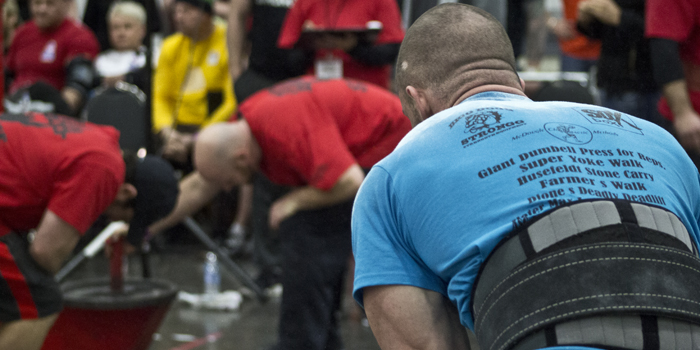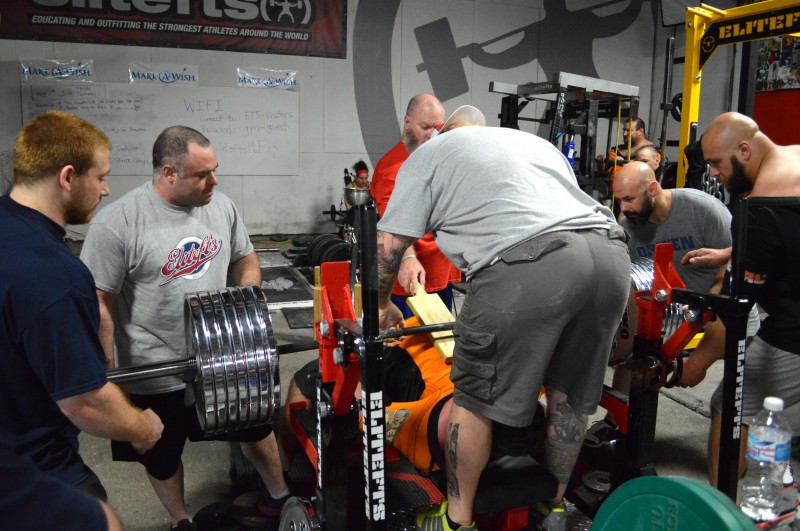
If you’ve been competing in strength sports for a long enough, it’s a fact that at some point, you’ll encounter an extended break. It could be because you need a mental break, you’re injured, or life happened. You don’t want to lose your gains and it would be great if you could simply start up where you left off, but that’s not going to happen. However, with some intelligent programming you can actually get back to training in such a way that you’ll be blowing through your old numbers without ever getting stuck.
Setting up this program, we have two primary concerns: The first is that your technique is probably off, to some degree, from what it once was. The second is that your work capacity is likely out the window. In order to address the technique work, the best thing to do is keep the weight and reps low, especially at first. I would sit between 65 and 80% of your 1 RM. Now here’s the important part: You have to choose a real time one rep max. So choose a number you know you could execute with perfection TODAY, not what you used to be able to do. Keep the reps in the doubles and triples and get in lots of sets, anywhere from 6-10. A good example of this would be 8 sets of 3 reps with 70% for bench press. Use this solely as technique work.
RECENT: Group Training: Use Your Constraints for Program Construction
Choose two to three specific cues for each lift to concentrate on and execute. Be explosive, and try to just blow this weight up. This is a perfect opportunity for you slow grinders out there to build up some power. You’ll be increasing the weight as the speed increases. You won’t be truly building strength here, but you’ll be cashing in on muscle memory and restoring or rebuilding motor patterns. Do this for 4-6 weeks. Cycle in and out of sets and reps and intensity. Your gut will tell you to just keep hammering heavier and heavier weights as they get easier and easier but don’t do it. That’s exactly how you’ll hit that wall.
I’ve come up with a pretty reliable, long term system of increasing weights. For a guy of above average level strength, add five pounds to bench max every other week and five pound to squat and deadlift max every week. It depends on where your numbers are. If you’ve only lost about 20 pounds from your bench, you could do five pounds every third week, for example. Some guys peak out big time. I used to have a variation of about 75 pounds on my deadlift between off season and peak week. I knew the curve existed so I trained accordingly. I spent plenty of time banging my head against a wall because I was frustrated that I couldn’t move the same weight. Fortunately I eventually learned and that’s when my ability to peak hit another level.
Once your technique is smooth and the weights are flying, something that has helped me out is to push myself after technique work with a set to technique failure. This does not mean to just go full dumb-dumb and get as many reps as possible. It means that you should do a rep perfectly and then another, rinse and repeat until fatigue causes your technique to break down. At this point, STOP! Now, you can’t do this for every exercise several times a week, so I recommend doing this with one exercise per week using weights between 75-85%. Use this method for 4-6 weeks.
Then what you’ll do is your assistance work. The assistance work is where you’ll be pushing the intensities. Get in plenty of volume here with low impact stuff so that as your strength increases, you’ll be recovering really nicely and you’ll be able to swap out some of the fluff work for meat and potatoes assistance stuff. A logical progression here would be to do lots of dumbbell and machine work at first — get in low impact volume and pump tons of blood. This will also help with any atrophy you’ve experienced. Also, this is a great point to work on tendon strength. Slow eccentric exercises are a staple in many rehab programs because of their efficacy in building tendon strength. Then after you start feeling okay with the volume and recovery, add in some main lift compound variations like good mornings or paused squats. Then when you’re back in full shape, start incorporating more intense variations of the main lifts, like chain work and super maximal weight work. For example, two board chain bench or block pulls against chains, or Dave Tate’s favorite, reverse band floor press.
Finding Strength: Team BSS Training and Fitness
Now here comes the curveball, if you want to train for strongman you’ll need a longer window. The reason is strongman just absolutely beats the crap out of you. You need really, really great recovery to be able to do strongman events constantly. So something I might suggest at first is to not do any for four weeks. Get yourself to a point where you can sustain a reasonable training frequency and volume in the gym without feeling like you got hit by a bus, then start by working in light sprints with the implements. Things like 50 foot sprints with a light keg for 6-8 sets with low rest, or a 50 foot yoke or farmers that you can move very quickly with (not run), or stones for height. Then, as you progress, and you’re able to handle the volume, slowly increase weights, still making technique and speed a priority. You’ll notice if you’ve read my previous articles I’m not big on maximal strongman training with any type of frequency because of how much it beats you up. Ask any of my athletes how often they touch contest weight in a long training cycle for a meet – two to three times, max, depending on how difficult the weight is for them.
That’s really all there is. There’s no secret here; the thing is to not rush into it. You have to remove your ego from the training and be sensible. Don’t try to gain it all back at once. Use the time you have to your benefit and hammer your weaknesses, whether that’s triceps or shoulders or hamstrings or just technique. While you’re distracted focusing on that stuff, the strength will continue to build and you’ll be matching and beating your old numbers in no time at all.










